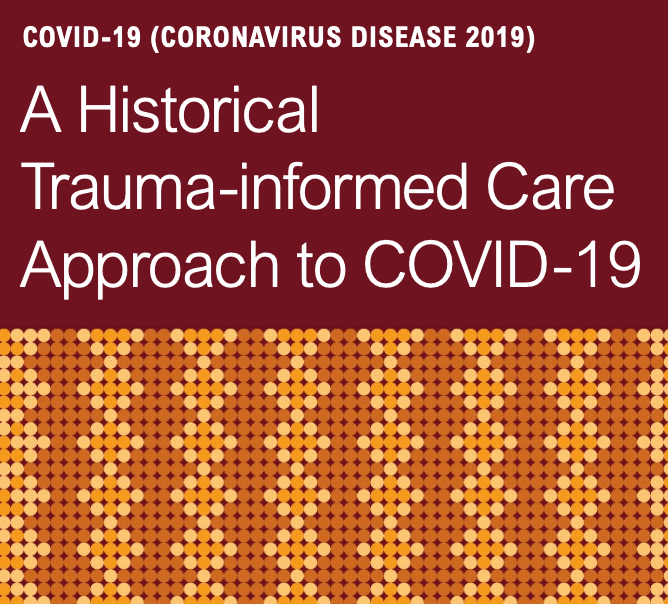Urban Indian Organizations are finding ways to support communities experiencing multiple traumas during the coronavirus (COVID-19) pandemic. COVID-19 poses an immediate health risk and may lead to traumas like unemployment, homelessness, and financial insecurity. People may also be experiencing historical and ongoing trauma from loss of language, forced assimilation, and racism. As Indigenous people, we can realize, recognize, and respond to the effects of our trauma by practicing Historical Trauma-informed Care. This approach is rooted in safety, trust, peer support, collaboration, community voice, and resilience. Urban Indian Organizations can be part of healing communities by reflecting these values in actions and by building a better future for the next generations.
How can organizations be more transparent about COVID-19?
Explain why practices and policies are changing across the organization. Share this information internally and through social media.
- Be consistent with national, state, or tribal
restrictions. - Be open to diverse feedback and critique.
- People may feel scared, tired, angry, anxious, or unconcerned
- Try using humor to lighten up the reality of COVID-19.
Invite community members to ask questions on social media and provide thoughtful, data-driven answers.
- Ask questions like, “What would you like to know about COVID-19?”
- Address misinformation with facts from sources like the Centers for Disease Control and Prevention.
How can organizations emotionally support the people they serve through telehealth services?
Speak with a calm and slow voice. Listen carefully and repeat back what you heard the individual say.
Respect emotional boundaries. Be mindful of verbal or non-verbal cues that communicate their willingness to share. For some, it may be best to avoid asking more questions on emotionally charged topics.
Explain the need for asking for sensitive information. Describe how you are protecting their privacy. Ask if they can have a conversation without it being overheard.
Ask for feedback at any point in the visit. Each person is unique—ask how you can best support them.
Use supportive, non-judgmental language. Ask, “How do you feel about ________?” and affirm the feelings that they share. Avoid telling them to get over it and dismissing what they are going through.
How can organizations support staff in caring for themselves and their communities?
Acknowledge common signs of compassion fatigue: feelings of distrust, exhaustion, anger/irritability, stress, anxiety, helplessness, cynicism, and dread.
Ask staff members what they need to support their well-being. This can be through an anonymous survey and group or one-on-one video chats. Clarify staff roles and expectations on an ongoing basis.
Being proactive can help set boundaries and improve transparency. Encourage forms of healing throughout the week. Open and close meetings with a prayer. Ask someone to share a good story or joke.
Create opportunities for connection. Share a virtual meal together. Host a virtual storytelling time. Try to have meetings over video, if possible
How can organizations support communities in handling their emotions?
Provide resources on trauma exposure, its impact, and treatment. Share the resources on your internal/external websites and through social media. Lead weekly videos that promote grounding and connection including:
- mindfulness meditations, breathing exercises, prayers, and songs—ground in the present moment.
- smudging or drumming sessions—have community members describe what they are experiencing through their five senses: sight, smell, touch, taste, hearing.
- storytelling of creation stories—help explain the world, how we are connected, and why things happen.
- virtual healing circles—hear what others are going through, recognize grief, and offer words of advice.
- virtual crafting circle—learn and share crafting techniques (e.g., beading, weaving).
How can organizations work together to heal their communities?
Host a discussion on how vaccines protect our communities, elders, and culture. Invite medical professionals, leaders, and community members. Start by acknowledging the history of research mistrust and how agencies are trying to move forward in a good way.
Host virtual trainings on trauma and resilience during COVID-19. Find out what the community wants to know about trauma and its impact.
Hold virtual conversations on healing from trauma. Invite elders, aunties/uncles, and youth. Come equipped with local, state, and national resources.
Create and share an inclusive resource list on websites and social media. Include resources related to COVID-19 testing, vaccines, food and rental assistance, gender-based violence, homelessness, child welfare, LGBTQ2S+ health, etc.
More COVID-19 resources
We offer many resources for tribes and urban Indian-serving organizations as well as healthcare providers and community members to help ensure that information is shared to keep our relatives safe and healthy. www.uihi.org/covid

